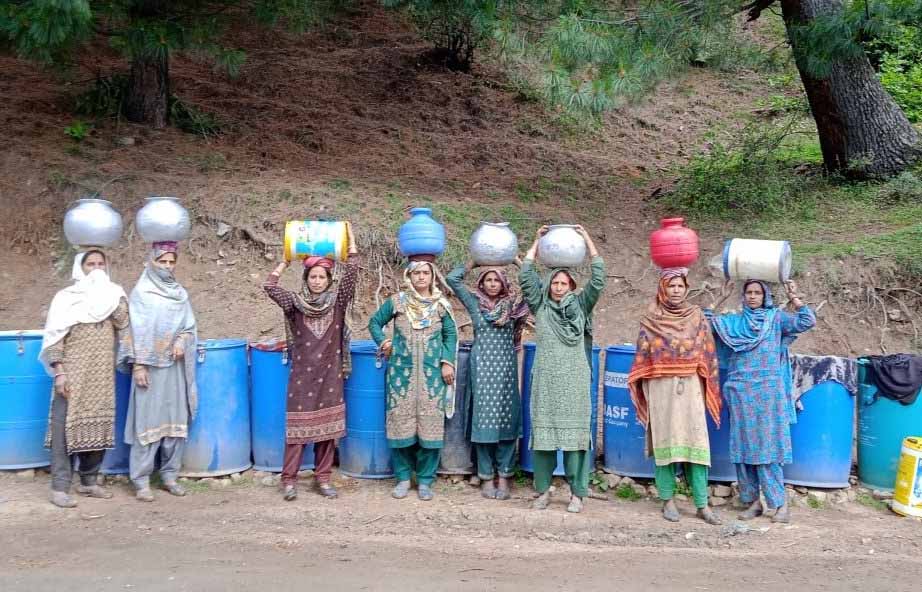Er. Amir Gulam Lone
As the chill of winter gives way to the soft warmth of spring in Kashmir, the valley is poised for a season of growth and rejuvenation. This year, however, spring not only heralds the blossoming of orchards and lush fields but also brings a growing sense of concern. The region is facing a troubling decline in water levels, impacting both surface water and groundwater sources, largely attributed to significantly low precipitation during the winter months. This water scarcity, exacerbated by the anticipated increase in agricultural and horticultural activities, poses a serious threat to our water quality and, ultimately, public health.
Kashmir’s economy is closely linked to its agriculture and horticulture. As farmers gear up for the season, the application of chemical fertilizers, pesticides, and herbicides is expected to rise. While these substances are vital for securing crop yields, their excessive use can result in severe consequences. Chemicals leaching from fields into rivers, streams, and lakes can accumulate over time, polluting the very water supplies that communities depend on for drinking, cooking, and sanitation. The contamination from substances like Chlorpyrifos, Glyphosate, Imidacloprid, and others can have dire implications when these pollutants seep into drinking water supplies.
The ramifications of such contamination are vast. Waterborne diseases, including cholera, typhoid, and hepatitis, thrive in polluted environments, posing a significant threat to public health. Vulnerable populations, particularly children, the elderly, and individuals with weakened immune systems, are at heightened risk. Furthermore, prolonged exposure to pesticide-tainted water has been associated with long-term health issues such as cancer, neurological disorders, and reproductive complications. The economic impact of treating these health conditions adds additional strain to an already vulnerable population.
The situation is further exacerbated by dwindling water levels. A decrease in both snowfall and rainfall has resulted in reduced flows in rivers and streams, while groundwater reserves are depleting at an alarming rate. This scarcity not only restricts access to clean water but also intensifies the concentration of pollutants in the remaining water bodies, creating a hazardous environment that threatens both human health and the fragile ecosystems of the region.
Given these pressing issues, it is vital for individuals and communities to take immediate action to protect their drinking water. While boiling water can effectively kill bacteria and viruses, it is insufficient against chemical pollutants like pesticides and heavy metals. Advanced water filtration systems should be implemented as a necessity. Technologies, including activated carbon filters, reverse osmosis (RO) systems, and ultraviolet (UV) purification, can successfully eliminate harmful chemicals and pathogens from water. It is imperative for households, schools, and public institutions to prioritize the installation of such systems to ensure their safety. Additionally, community-based water treatment plants with modern filtration processes should be established to provide clean water to larger groups.
Addressing this crisis will require a comprehensive approach. There is an urgent need for stricter regulation and oversight of agricultural practices. Farmers should be encouraged to adopt sustainable practices such as integrated pest management and organic farming, which mitigate the use of harmful chemicals. Government and non-governmental organizations can play a crucial role by providing training, resources, and incentives to facilitate this transition.
Furthermore, public awareness regarding water conservation is essential. Implementing rainwater harvesting, applying efficient irrigation methods, and restoring traditional water management practices can help lessen the effects of water scarcity. Communities must be educated about the hazards of water pollution and proactive measures they can take to protect their water sources.
At a systemic level, policymakers must focus on developing robust infrastructure for water treatment and distribution. Investing in contemporary filtration systems and ensuring regular monitoring of water quality are vital to safeguard public health. Additionally, comprehensive research is needed to evaluate the extent of water contamination and its impact on both human health and the environment.
The existing water crisis in Kashmir transcends environmental concerns; it represents a public health emergency. If ignored, this issue could devastate communities, disrupt livelihoods, and undermine the region’s economic stability. The time to take decisive action is now. Through the adoption of sustainable practices, investment in infrastructure, and the cultivation of a conservation-minded culture, we can preserve our vital water resources and secure a healthier and more stable future for generations to come.
As the people of Kashmir look forward to the arrival of spring, let us also pledge to protect the lifeblood of our valley—its water. The stakes are too high to overlook. Let this season be one of not only renewal but also accountability.
The author holds a Gold medal in Environmental Engineering from Aligarh Muslim University (AMU).
M.Tech(Environmental Engineering) linkedin.com/in/amirgulam
(Gold-Medalist) – AMU


Leave a Reply